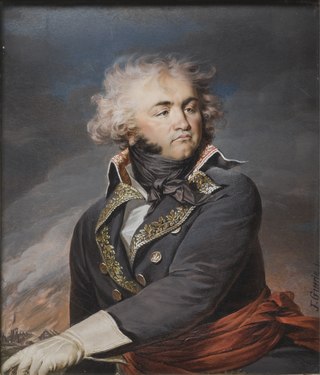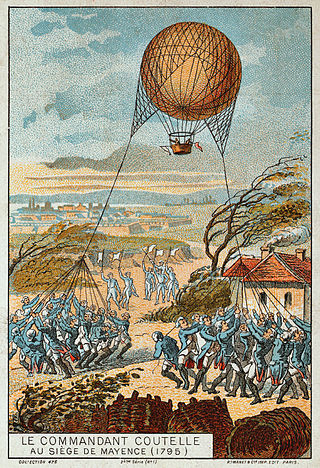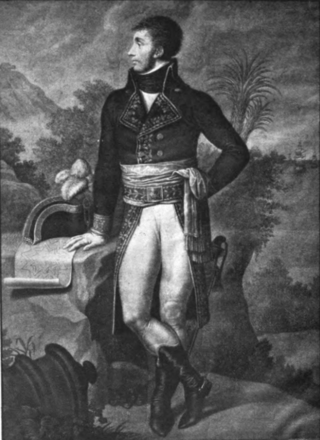
Jean-Baptiste Kléber was a French military leader of the French Revolutionary Wars. After serving for one year in the French Royal Army, he entered Habsburg service seven years later. However, his humble birth hindered his opportunities. Eventually, he volunteered for the French Revolutionary Army in 1792 and quickly rose through the ranks.

The Army of Sambre and Meuse was one of the armies of the French Revolution. It was formed on 29 June 1794 by combining the Army of the Ardennes, the left wing of the Army of the Moselle and the right wing of the Army of the North. Its maximum paper strength was approximately 120,000.

The Battle of Mainz saw a Habsburg Austrian army led by Field Marshall François Sebastien Charles Joseph de Croix, Count of Clerfayt launch a surprise assault against four divisions belonging to the French Army of Rhin-et-Moselle directed by General of Division François Ignace Schaal. The right-most French division was completely routed and all the French troops were compelled to retreat with the loss of their siege artillery and many casualties. Clerfayt followed up his Rhine campaign of 1795 victory by driving most of General of Division Jean-Charles Pichegru's Army of Rhin-et-Moselle south. The War of the First Coalition action was fought near the city of Mainz in the modern-day state of Rhineland-Palatinate in Germany.

The Army of the Rhine was formed in December 1791, for the purpose of bringing the French Revolution to the German states along the Rhine River. During its first year in action (1792), under command of Adam Philippe Custine, the Army of the Rhine participated in several victories, including Mainz, Frankfurt and Speyer. Subsequently, the army underwent several reorganizations and merged with the Army of the Moselle to form the Army of the Rhine and Moselle on 20 April 1795.

The Army of the Rhine and Moselle was one of the field units of the French Revolutionary Army. It was formed on 20 April 1795 by the merger of elements of the Army of the Rhine and the Army of the Moselle.

François Antoine Louis Bourcier was a French cavalry officer and divisional general of the French Revolutionary Wars and the Napoleonic Wars.

Nicolas Léonard Beker or Nicolas Léonard Becker or Nicolas Léonard Bagert, joined the French army as a dragoon before the French Revolutionary Wars and rose in rank to become a general officer. In 1800 he married the sister of Louis Desaix, who was killed at the Battle of Marengo. He led an infantry brigade in the 1805 campaign and commanded a dragoon division in 1806 and 1807. In 1809 he became chief of staff to Marshal André Masséna but ran afoul of Emperor Napoleon and was banished from the army for several years.
The Battle of Friedberg was fought on 24 August 1796 between a First French Republic army led by Jean Victor Marie Moreau and a Habsburg Austrian army led by Maximilian Anton Karl, Count Baillet de Latour. The French army, which was advancing eastward on the south side of the Danube, managed to catch an isolated Austrian infantry regiment. In the ensuing combat, the Austrians were cut to pieces. Friedberg is a Bavarian town located on the Lech River near Augsburg. The action was fought during the War of the First Coalition.

André Poncet commanded a French infantry division during the French Revolutionary Wars. He joined the French Royal Army in a famous regiment and fought in the American Revolutionary War. Becoming a general officer in early 1794, he fought at Fleurus, Maastricht and other actions. He led a division in the Rhine Campaign of 1795 at Höchst and in the Rhine Campaign of 1796 at Limburg. Afterward, he held interior posts until his retirement from the military in 1811. He became mayor of his home town of Pesmes. When it was occupied by the Austrians in 1814, he was arrested and confined in the Palanok Castle in distant Transylvania for five months. He became a farmer and died in 1838 after returning to France. His surname is one of the names inscribed under the Arc de Triomphe, on Column 6.

In the Rhine campaign of 1796, two First Coalition armies under the overall command of Archduke Charles outmaneuvered and defeated two French Republican armies. This was the last campaign of the War of the First Coalition, part of the French Revolutionary Wars.
Pierre Garnier, comte de Laboissière was a French army general who commanded an infantry division during the War of the Second Coalition. After enrolling in a military academy in 1769, he joined a dragoon regiment in 1772 as a sous lieutenant. In 1779, he was promoted to captain. In late 1792 during the War of the First Coalition he was given command of a cavalry regiment with the grade of colonel. While serving in the Army of the Rhine he was captured by the Prussians. After a prisoner exchange, he was promoted to général de brigade in October 1793. Laboissière was promoted to général de division in February 1799. He fought at Stockach and led a division at Novi. In the summer and fall of 1799 he fought in several actions near Genoa. Later he commanded troops in Switzerland. Napoleon appointed him to the Sénat conservateur in 1802, awarded him the Commander's Cross of the Légion d'Honneur in 1804 and made him a comte de l'empire in 1808. He died in Paris in April 1809. His surname is one of the names inscribed under the Arc de Triomphe, on Column 15.

In the Rhine campaign of 1795 during the War of the First Coalition, two Habsburg Austrian armies under the command of François Sébastien Charles Joseph de Croix, Count of Clerfayt, defeated two Republican French armies attempting to invade the south German states of the Holy Roman Empire. At the start of the campaign, the French Army of the Sambre and Meuse, led by Jean-Baptiste Jourdan, confronted Clerfayt's Army of the Lower Rhine in the north, while the French Army of the Rhine and Moselle, under Jean-Charles Pichegru, lay opposite Dagobert Sigmund von Wurmser's Army of the Upper Rhine in the south. A French offensive failed in early summer but in August, Jourdan crossed the Rhine and quickly seized Düsseldorf. The Army of the Sambre and Meuse advanced south to the Main River, isolating Mainz. Pichegru's army made a surprise capture of Mannheim and both French armies held significant footholds on the east bank of the Rhine.

Jean Hardy commanded a French division during the French Revolutionary Wars. In 1783 he enlisted in the French Royal Army. In 1792 he joined a volunteer battalion and fought at Valmy, earning promotion to major. After leading a battalion at Wattignies and successfully holding Philippeville in 1793, he became a general of brigade. In 1794, he led troops in the Army of the Ardennes at Boussu-lez-Walcourt, Grandreng, Gosselies and Fleurus.

Pierre Raphaël Paillot de Beauregard led a French division at the Battle of Wattignies. A nobleman, he joined the French Royal Army as a cadet in 1755 and fought in the Seven Years' War. He became a lieutenant colonel in 1779, but two years later got into a dispute with a superior officer and was placed on inactive service. The French Revolution and the War of the First Coalition saved his career; he was promoted general of brigade in 1792. He led a 2,000-man column at Arlon in 1793 but irritated his army commander. After his 5,800-strong division performed poorly at Wattignies he was put in prison for 10 months. He was briefly employed again during the War in the Vendée in 1795 before retiring from military service in 1796.
François Muller became a division commander during the French Revolutionary Wars. He enlisted in the French Royal Army as a cavalry trooper in 1783 and served until 1789. He joined a Paris volunteer battalion in 1792 and became an officer. Sent to fight in the War in the Vendée, he was promoted general of brigade and general of division within the span of nine days. His division ran away at both Cholet and Le Mans and he was reportedly drunk at the Battle of Dol, yet he was transferred in March 1794 to the Army of the North. In May and June he led a combat division at the battles of Grandreng, Erquelinnes, Gosselies, Lambusart and Fleurus. Removed from command in August 1794, he was thereafter assigned to posts in the interior. He led a division at Genola in November 1799 before being deactivated in 1801. Entangled in the 1804 affair of Jean Victor Marie Moreau, he was placed under house arrest at Orléans and died there in 1808.

Jean Étienne Philibert de Prez de Crassier or Étienne Desprez-Crassier was a French political and military leader in the early years of the French Revolutionary Wars. Despite being from the minor nobility, he entered the French Royal Army as a cadet at the age of 12 because of his family's poverty. He fought in the War of the Austrian Succession and the Seven Years' War, becoming a colonel in 1785 and retiring two years later. Voltaire lent him the money needed to recover the Deprez family property. He was elected to the Estates General as a nobleman in 1789. After being promoted to lieutenant general he led a division at Valmy in 1792. He became commander of the Army of the Rhine and Army of the Western Pyrenees. Imprisoned during the Reign of Terror, he was released and restored to his former rank but retired in 1796.
The Battle of Maudach occurred on 15 June 1796 between the French Revolutionary Army and the Army of the First Coalition. This was the opening action of the Rhine Campaign of 1796 on the Upper Rhine, slightly north of the town of Kehl. The Coalition, commanded by Franz Petrasch, lost 10 percent of its manpower missing, killed or wounded. It was fought at the village of Maudach, southwest of Ludwigshafen on the Rhine river opposite Mannheim. Maudach lies 10 km (6 mi) northwest of Speyer and today is a southwest suburb of Ludwigshafen; a principal town on the Rhine river in 1796.
In the Rhine Campaign of 1796, two First Coalition armies under the overall command of Archduke Charles outmaneuvered and defeated two Republican French armies. This was the last campaign of the War of the First Coalition, part of the French Revolutionary Wars.
The Battle of Limburg, also called the Battle of Friedberg, was a battle of the War of the First Coalition, itself part of the French Revolutionary Wars. It took place on 9 November 1792 at Limburg an der Lahn between French Revolutionary forces and Prussian troops, ending in a French victory.

Ludwig Wilhelm Anton, Count Baillet de Latour-Merlemont served as an Austrian general during the French Revolutionary Wars. From a noble family, he joined the Austrian army as a volunteer in 1767 and fought in the War of the Bavarian Succession as a commissioned officer. He was promoted to command an infantry regiment in 1788 and fought in the Austro-Turkish War. He became a Generalmajor in 1794 during the War of the First Coalition against France. He fought in the Rhine campaign of 1795 and led a division in numerous battles during the Rhine campaign of 1796. He was known as Count Baillet or Count Baillet-Merlemont to distinguish him from his higher-ranking older brother Maximilian Anton Karl, Count Baillet de Latour. He was promoted Feldmarschall-Leutnant in 1797.











